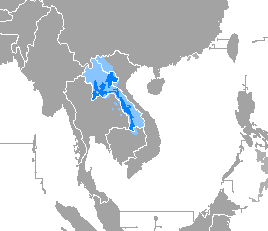
Back Lao (taal) Afrikaans लाओ भाषा ANP لغة لاو Arabic لاو (لغه) ARZ Idioma laosianu AST Laos dili Azerbaijani لائوس دیلی AZB Basa Laos BAN Tataramon na Lao BCL Лаоская мова Byelorussian
| Lao | |
|---|---|
| ພາສາລາວ, Phasa Lao | |
| Pronunciation | [pʰáː.sǎː láːw] |
| Native to | Laos Thailand (Isan) Cambodia (Stung Treng, Preah Vihear and Ratanakiri) Vietnam (Điện Biên, Lai Châu and Sơn La) China (Xishuangbanna) |
| Ethnicity | Lao Isan |
| Speakers | L1: 3.7 million (2015)[1] L2: 800,000 (no date)[2] |
| Dialects |
|
| Lao script in Laos Thai script in Thailand Thai and Lao Braille | |
| Official status | |
Official language in | |
Recognised minority language in | |
| Regulated by | Educational Science Research Institute, Ministry of Education and Sports and Institute of Social Sciences, Faculty of Arts, National University of Laos |
| Language codes | |
| ISO 639-1 | lo |
| ISO 639-2 | lao |
| ISO 639-3 | Either:lao – PDR Laotts – Isan (Thailand Lao) |
| Glottolog | laoo1244 Laonort2741 Northeastern Thai |
| Linguasphere | 47-AAA-c |
 | |
Lao (Lao: ພາສາລາວ, [pʰáː.sǎː láːw]), sometimes referred to as Laotian, is the official language of Laos and a significant language in the Isan region of northeastern Thailand, where it is usually referred to as the Isan language. Spoken by over 3 million people in Laos and 3.7 million in all countries, it serves as a vital link in the cultural and social fabric of these areas. It is written in the Lao script, an abugida that evolved from ancient Tai scripts.[3]
Lao is a tonal language, where the pitch or tone of a word can alter its meaning, and is analytic, forming sentences through the combination of individual words without inflection. These features, common in Kra-Dai languages, also bear similarities to Sino-Tibetan languages like Chinese or Austroasiatic languages like Vietnamese. Lao's mutual intelligibility with Thai and Isan, fellow Southwestern Tai languages, allows for effective intercommunication among their speakers, despite differences in script and regional variations.[4]
In Laos, Lao is not only the official language but also a lingua franca, bridging the linguistic diversity of a population that speaks many other languages. Its cultural significance is reflected in Laotian literature, media, and traditional arts. The Vientiane dialect has emerged as the de facto standard, though no official standard has been established. Internationally, Lao is spoken among diaspora communities, especially in countries like the United States, France, and Australia, reflecting its global diasporic presence.[5]
- ^ PDR Lao at Ethnologue (27th ed., 2024)

Isan (Thailand Lao) at Ethnologue (27th ed., 2024)
- ^ Lao language at Ethnologue (27th ed., 2024)

- ^ "Lao". About World Languages. Archived from the original on 2017-12-27. Retrieved 2016-05-25.
- ^ "Ausbau and Abstand languages". Ccat.sas.upenn.edu. 1995-01-20. Archived from the original on 2013-01-19. Retrieved 2012-07-08.
- ^ Hays, Jeffrey. "LAO LANGUAGE: DIALECTS, GRAMMAR, NAMES, WRITING, PROVERBS AND INSULTS | Facts and Details". factsanddetails.com. Archived from the original on 2021-03-02. Retrieved 2020-12-19.